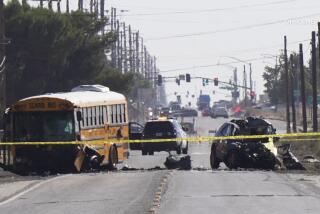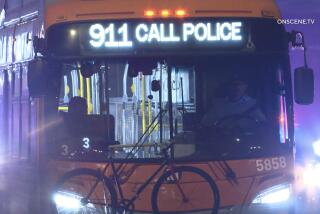CHP Blames Bus Driver Error for Accident
California Highway Patrol investigators have concluded that driver error led to an MTA bus accident last month in which a 40-foot coach veered off a freeway exit ramp in Sherman Oaks, struck a car and slammed into a palm tree, injuring 28 people.
After a search for mechanical problems, CHP crash specialists said the 25-year-old driver apparently panicked as she drove the packed bus off the northbound San Diego Freeway, and may have pumped the brakes when she should have applied hard, steady pressure.
The investigation included attempts to re-create key elements of the accident in a Dodger Stadium parking lot Thursday.
Investigators said driver Dominique Mix-Lawton was traveling about 35 mph at the time of the accident Jan. 17, despite an exit ramp sign that advises vehicles to slow to 10 mph.
And although witnesses told The Times that the driver had pumped the brakes before the crash, investigators said the proper procedure on such a bus--which is equipped with air brakes--would have been to simply brake hard and continuously.
If the driver did slam on the brakes, investigators said, she did it too late.
“You must be able to drive within your vehicle’s braking limit,” said Sgt. Paul J. Golonski, leader of the CHP’s accident investigation unit.
Mix-Lawton has told investigators that the brakes failed as she tried to slow the Metropolitan Transportation Authority bus, which was packed with 54 people as it headed from the Getty Center to Sherman Oaks, but that the warning systems designed to alert drivers to brake trouble never went off.
MTA inspection records show that no brake problems turned up in two routine checks in the week before the accident. CHP specialists also found that the brakes worked, and that the warning systems functioned normally.
“It wasn’t the bus,” said Officer Michael Curtin, another accident investigator. “It’s quite possible the brakes were applied, but not enough and not soon enough.”
According to investigators and witnesses, the bus took the Ventura Boulevard exit from the northbound San Diego Freeway at about 5 p.m. and failed to make the curve at the bottom. The bus crushed the side of a Honda Civic, which struck two other cars, before the bus careened into a palm tree, CHP officials said.
Early reports suggested that the brakes on bus No. 3398, purchased in 1984, might have failed. MTA officials have repeatedly come under fire for being slow to update the 2,000-coach fleet, 40% of which is more than 12 years old, when federal guidelines recommend that buses be taken out of service.
*
To simulate the circumstances leading to the crash, CHP specialists on Thursday tested the bus on a sloped parking lot at Dodger Stadium. Officers filled it with 8,000 pounds of sandbags to simulate the weight of passengers, then made about a dozen passes across the lot, slamming on the brakes and measuring the stopping distance.
Traveling at 40 mph down a 4% grade--the same as the exit ramp--the bus was able to stop about 150 feet from where the driver hit the brake pedal. The distance from the top of the exit ramp to the bottom is at least 300 feet, investigators said.
“It’s going to fall back on the driver,” Golonski said.
MTA officials will now conduct their own review of the accident. A review board of MTA instructors and supervisors will interview Mix-Lawton and other witnesses, visit the accident site and consult the CHP report before determining whether the accident was avoidable.
If the board finds that it was avoidable, the driver may appeal the finding.
“Even [after] the most minor accident, if it is the operator’s fault, we will send them for additional retraining . . . and depending upon the circumstances there could be other discipline [ranging] from time off without pay up to dismissal,” said Jon Hillmer, general manager of MTA bus operations.
Mix-Lawton declined to comment Thursday. She has been on leave to recover from injuries, including back pain, suffered in the accident. At least three passengers suffered broken bones.
Mix-Lawton was hired as a part-time driver in December 1996, and as a full-time driver in September 1997. She had driven Route 561 two days a week for only a month at the time of the accident, MTA officials said.
*
Drivers union spokesman Goldy Norton said Mix-Lawton’s experience level did not pose a threat to passenger safety.
“Anybody who is hired by the MTA and goes through all of the probationary periods is qualified,” Norton said.
MTA officials said there is no substitute for experience, but praised the agency’s preparation program.
“Every operator, whether they’ve been here 20 years or two years, if he goes to a new route, he needs to break in,” said Michelle Caldwell, deputy executive officer for transit operations. But, she added, “We have one of the most professional training programs. We feel confident we’re not putting people on the street who can’t handle Los Angeles.”
(BEGIN TEXT OF INFOBOX / INFOGRAPHIC)
MTA Accidents
Accidents involving MTA buses over the past 10 years, including 1990 peak:
Total MTA Traffic Accidents 1988-98
Unavoidable: 28,507 (84.5%)
Avoidable: 5,242 (15.5%)
*
1990
Avoidable: 720
Unavoidable: 3,513
*
1998 Accidents (through Feb. 11)
Unavoidable: 168
Avoidable: 8
Source: Metropolitan Transportation Authority
More to Read
Sign up for Essential California
The most important California stories and recommendations in your inbox every morning.
You may occasionally receive promotional content from the Los Angeles Times.










